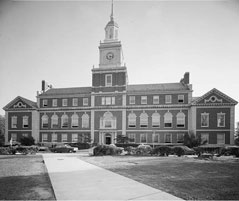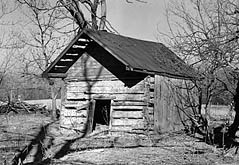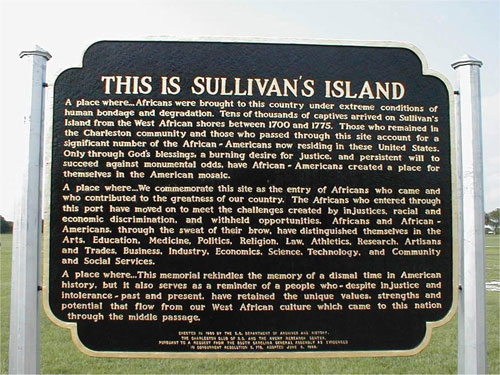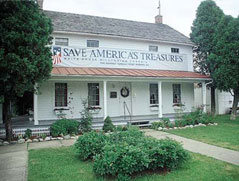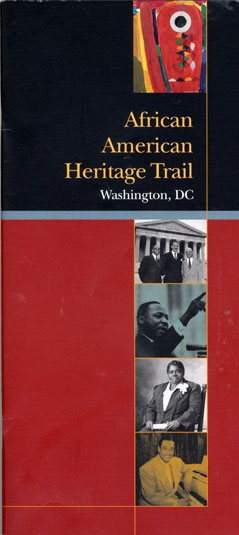Historic Act of 1935
Significance
Historic Sites Act of 1935
Major Provisions
- Declares preservation for public use historic sites, buildings, and objects of national significance (16 U.S.C. 461)
- Establishes the Historic American Buildings Survey/ Historic American Engineering Record and Historic American Landscapes Survey (16 U.S.C. 462(a))
- Basis for National Historic Landmarks Program (16 U.S.C. 462(b))
- Requires protection of historic properties and related museums
- Authorizes historic marker programs (16 U.S.C. 462(f-g))
- Supports historic education programs and services (16 U.S.C. 462j)
The Historic Act of 1935 established the principle that preservation of historic sites, buildings, and objects had significance to the nation. Based on that principle, the National Park Service established the Historic American Buildings Survey and the Historic American Engineering Record program (referred to collectively as (HABS/HAER)).
The HABS/HAER programs are integral components of the federal government’s commitment to historic preservation. The programs document important architectural, engineering, and industrial sites throughout the United States and its territories. They also document African American buildings from humble slave cabins as shown in the photograph on the left to architecturally elite buildings like the Founders’ Library at Howard University seen in the photograph below.
The federal government established HABS/HAER as a make-work program for architects, draftsmen, and photographers left jobless by the Great Depression. Guided by field instructions from Washington, DC, the first recorders were tasked with documenting a representative sampling of America’s architectural heritage. By creating an archive of historic architecture, HABS provided a database of primary source material for the then fledgling historic preservation movement (HABS/HAER Website). To insure that such evidence is not lost to future generations, the HABS/HAER Collections are archived at the Library of Congress, where they are available to the public in the Prints and Photographs Division. Many of the images are digitized and available on the internet.
The Act also established the basis for Historic Marker Programs administered
by State Historic Preservation Offices. Some states had marker programs before
the Historic Act of 1935; South Carolina is a case in point. Its marker program
was established by state law before the passage of the federal Antiquities Act.
“South Carolina Historical Markers, like marker programs of other states, mark and interpret places important to an understanding of the state’s past, either as the sites of significant events, or at historic properties such as buildings, sites, structures, or other resources significant for their design, as examples of a type, or for their association with institutions or individuals significant in local, state, or national history. (South Carolina Department of Archives and History 2005)."
The justification for the Park History Program is found in the Historic Sites Act, as is the basis for the National Historic Landmarks (NHL) program. However, it was under the legislative authority of the National Historic Preservation Act that these programs were established and came under the purview of the National Park Service.
National Historic Preservation Act of 1966 (amended)
“The Congress finds and declares that the spirit and direction of the Nation are founded upon and reflected in its historic heritage. The historical and cultural foundations of the Nation should be preserved as a living part of our community life and development in order to give a sense of orientation to the American people. …although the major burdens of historic preservation have been borne and major efforts initiated by private agencies and individuals, and both should continue to play a vital role, it is nevertheless necessary and appropriate for the Federal Government to accelerate its historic preservation programs and activities, to give maximum encouragement to agencies and individuals undertaking preservation by private means, and to assist State and local governments and the National Trust for Historic Preservation in the United States to expand and accelerate their historic preservation programs and activities…” (16 U.S.C. 470(1-b)).
Significance
National Historic Preservation U.S.C. Section 101 (a-h), Section 110 470 h-2(a-c, i), Section 201 Major Provisions
The Act establishes the:
- National Register of Historic Places.
- National Historic Landmark Designation.
- Criteria for nominating and designating properties to the Register and as National Historic Landmarks.
- State Historic Preservation Programs, designation of State Historic Preservation Officers, and delineates their responsibilities.
- Mechanisms for Certified Local Governments –Federal partnerships.
- Tribal historic preservation program assistance including criteria for Tribal Historic Preservation Officers and delineation of their responsibilities.
-
Requirements for consultation with Indian Tribes on places of traditional
religious and cultural significance, in identifying and determining treatment modalities within the area of potential effect of an undertaking. - Eligibility of traditional religious and cultural properties for National Register listing.
- Matching grants fund for state historic preservation programs.
- Direct grant program to states, grants and loan programs to American Indians, native Hawaiians, Alaskan natives, Pacific Islanders, and to not-for-profit ethnic and minority organizations to be used for preserving cultural heritage.
- Federal agency preservation program, designation of federal preservation officers, and delineates their responsibilities.
- Advisory Council on Historic Preservation.
- Principle that Environmental Impact Statements are required only as directed by National Environmental Policy Act (42 U.S.C.4335 Section 102).
A Special Committee on Historic Preservation of the U.S. Conference of Mayors recommended that the United States adopt a public policy in support of the preservation and protection of our country’s significant historic places for future generations of Americans. In that report, the Special Committee also made broad recommendations on the pressing need for this nation to establish a strong federal historic preservation program (Tiller 2003).
In response to the Conference of Mayors Report, Congress passed the National Historic Preservation Act of 1966 establishing a national historic preservation program (Tiller 2003). With the enactment of this piece of legislation, and its many subsequent amendments, “the federal government became the partner of public historic preservation, “a partner…in saving America’s historic buildings and neighborhoods…” said Richard Moe, the president of the National Trust for Historic preservation (1996). “By creating an effective public/private partnership,” Moe continued, “NHPA has given preservation a place at the decision-making table, an authoritative voice in the discussions that shape the look, the livability, and the future of communities. That alone is reason to recognize this legislation as one of the seminal documents in the history of the American preservation movement (Moe 1996)."
Heritage and Historic Preservation in the United States is an effective public-private partnership, mainly because it embodies what the Secretary of the Interior characterizes as the “Four Cs”—Communication, Consultation and Cooperation, all in the service of Conservation (Matthews 2005). The National Historic Preservation Act is the key legislation establishing the organizational framework and collaborative processes that make public-private partnership effective on the national, state, and local level. The key programs that make up that framework and administer those processes are the:
- National Register of Historic Places,
- National Historical Landmarks,
- Historic Preservation Fund,
- Historic Tax Incentives Program, and the
- Section 106 consultation process (Matthews 2005:1).
The National Register of Historic Places is unique in its recognition of “local historic significance.” According to Tiller, no other national system does this. Two-thirds (66%) of the properties listed on the National Register are designated for their significance to local citizens and local history. That policy is based on a vision borne almost 40 years ago that local citizens and their local and state governments know best those places important to preserve a unique sense of history and community for future generations—and not the federal government (Tiller, 2003). Learn More about African American listings in the National Register of Historic Places and other NHPA preservation programs administered by the National Park Service.
The National Register of Historic Places is the Nation's official list of cultural resources worthy of preservation. The National Register of Historic Places, administered by the National Park Service, is the Nation's official list of cultural resources worthy of preservation.
The Register not only coordinates and supports public and private efforts to identify, evaluate, and protect our historic and archeological resources it also lists districts, sites, buildings, structures, and objects that are significant in American history, architecture, archeology, engineering, and culture.
African American Listings
The Register lists approximately 78,000 properties. Of these listings, there are 822 African American listings in 38 states and the Virgin Islands identified in the National Registers” on-line “listings by subject.” This number does not reflect the actual number of African American historic properties listed on the register because 209 of those listed are “multiple properties” that is they are listings representing more that one property. For example “Historically Black Properties in Little Rock's Dunbar School Neighborhood Multiple Properties Listing in Arkansas includes 2 historically black colleges, (1) high school, (1) junior high school, (24 historically black churches a YMCA (3) and the sites of a former general hospital for “black patients” as well as a “ small privately-owned amusement park for African-Americans and 3 funeral homes ( National Register 1999)66. Martin Luther King Jr. Birth Home is located in Auburn Avenue Historic District in Atlanta. Learn more about listing a property in the National Register of Historic Places.
State Historic Preservation Programs assist citizens, units of local government, and public and private organizations to locate and document historic properties to the National Register; aids local governments and federal agencies in meeting historic preservation statutes, and in assessing the impact of federal projects on historic places.
Tribal Historic Preservation Programs have similar functions in relation to their respective tribal governments. There are 52 tribal governments participating in the program.
Locate the State and Tribal Historic Preservation Office in your state.
Local governments that take action to preserve their unique historic character may apply to the State Historic Preservation Office to be come certified as partners with the state in historic preservation. Certified Local Governments (CLG) are eligible for National Park Service technical assistance and small grants. The CLGs identify historic properties and enforce legislation to protect it. The CLGs foster public participation in the local historic preservation program. The program is administered by the Heritage Preservation Services, National Park Service, and United States Department of the Interior. Learn more about the Certified Local Governments Program.
Heritage Preservation Services of the National Park Service, helps citizens and communities to identify, evaluate, protect and preserve historic properties for future generations of Americans. The program provides a wide range of products and services, financial assistance and incentives, educational guidance, and technical information in support of this mission. Its diverse partners include State Historic Preservation Offices, local governments, tribes, federal agencies, colleges, and non-profit organizations. It administers the CLG program, grants for heritage preservation to states, CLGs, and tribal governments.
Cultural Tourism DC, a project funded by a grant from the Heritage Preservation services, National Park Service , produced this brochure. Learn more about the Heritage Preservation Services.
National Historic Landmarks are nationally significant historic places that, like Harriet Tubman’s home in New York, are designated by the Secretary of the Interior because they possess exceptional value or quality in illustrating or interpreting the heritage of the United States. There are 153 NHL’s included in the National Register of Historic Places, the official list of the cultural resources and historic properties worthy of preservation.
NHPA also established the Advisory Council on Historic Preservation (ACHP) as an independent federal agency in the partnership dedicated to historic preservation and as the major policy advisor to federal agencies on historic preservation. The Council members include representatives from every level of government and private citizens (Matthews 2005:6). ACHP issues federal regulations for implementing Section 106 of NHPA requiring consultation.
Section 106
Section 106 of the National Historic Preservation Act of 1966 (NHPA) requires federal agencies to take into account the effects of their undertakings on historic properties, and to afford the Advisory Council on Historic Preservation (ACHP) a reasonable opportunity to comment. The historic preservation review process mandated by Section 106 is outlined in federal regulations 36 CFR issued by ACHP. The latest revision of 36 CFR Part 800 incorporated amendments became effective May 5, 2004. Learn more about Section 106 and how it is implemented.
According to 36CFR Part 800, the goal of consultation is to:
- identify historic properties potentially affected by the undertaking,
- assess its effects, and
- seek ways to avoid, minimize, or mitigate any adverse effects on historic properties.
The regulations require that the federal agency official shall involve the consulting parties, for Park Service purposes these parties include:
- people traditionally associated with the park lands,
- park neighbors,
- local governments,
- other stakeholders, and
- tribal governments.
Impact on Heritage Preservation
The National Association of Tribal Historic Preservation Officers recently completed a study of the best practices for fulfilling the requirements under Section 106 for consultation with tribal governments. These include any Indian tribe or Native Hawaiian organization that attaches religious and cultural significance to historic properties that may be affected by an undertaking such as establishing a park, building a new structure, and the like. The study also includes information about the legal and historical backdrop of the consultation process and various laws and Presidential Executive Orders that relate to tribal matters (NATHPO 2005:13). Learn more about the characteristics of successful consultation according to tribal peoples surveyed in the study.
National Environmental Policy Act of 1969
The National Environmental Policy Act (NEPA) was passed by Congress in 1969 and took effect on January 1, 1970 with the mandate to:
&encourage productive and enjoyable harmony between man and his environment; to promote efforts which will prevent or eliminate damage to the environment and biosphere and stimulate the health and welfare of man; to enrich the understanding of the ecological systems and natural resources important to the Nation; and to establish a Council on Environmental Quality (42 E.S.C. 4331)."
The passage of NEPA reaffirmed the national commitment of the Organic Act of 1916 to conserve America’s scenery and the natural and historic objects and the wildlife for future generations while adding the dimensions of law and process to protecting the environment from the impact of human technological advancement.
Significance
National Environmental Policy Act of 1969 42 U.S.C. 4321 and 4331-4335
Major Provisions
-
Human Safety and Preservation linked:
Federal policies and programs must assure human safety while preserving the nation’s historic, cultural, and natural heritage -
Impact Statement:
Every recommendation or report on proposed Federal legislation or other major Federal action must include an Environmental Impact Statement that describes the possible beneficial, adverse, or no impact of the proposal -
Consultation:
Public input into decision making process on the principle that each person has a responsibility to contribute to the preservation and enhancement of the environment -
Interdisciplinary Approach:
All federal agencies use an interdisciplinary approach in planning and in decision-making
As with NHPA, this legislation called for public input into the decision-making process. NEPA charged all federal agencies to make a diligent effort to involve the interested and affected public before they make decisions. It provided the tools to carry out these goals by mandating that every federal agency prepare an in-depth study of the impacts of “major federal actions having a significant effect on the environment” and alternatives to those actions, and requiring that each agency make that information an integral part of its decisions. In the Park Service this means consultation with traditionally associated people, people in surrounding communities, and other park stakeholders.
Impact on Heritage Preservation
Prior to NEPA, the public had limited opportunities to engage in the debate about social, economic, and environmental costs and benefits. The public had little recourse to challenge the federal government on decisions affecting their communities. In a study of the effectiveness of NEPA, study participants applauded NEPA for opening the federal process to public input and were convinced that this open process has improved project design and implementation. The study concluded that NEPA provides agencies an extraordinary opportunity to respond to citizen needs and build trust in surrounding communities (Council on Environmental Quality 1997).




